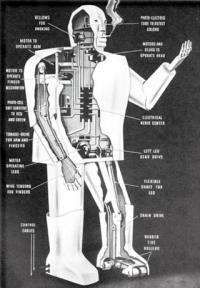Probing Question: Where are all the cool robots?

(PhysOrg.com) -- For the better part of a century, they’ve promised us robots. From Elektro, the 7-foot metal man of the 1939 World’s Fair, to Rosie the robot maid on "The Jetsons" to the android lieutenant commander Data on "Star Trek: The Next Generation," American pop culture has shown a future where humans do little work, leaving the heavy labor to their robot friends. Yet here we are in the year 2009 without a mechanical maid or butler in sight. It may seem petty to ask, but where are all the cool robots?
"They are all around you, if you know where to look!" said Sean Brennan, assistant professor of mechanical engineering at Penn State. When someone says "robots," we may think of the Terminator or the Iron Giant, Brennan said, but in their most basic form, robots are simply computer-controlled devices that respond to commands and to the world around them.
Take your car, for example, Brennan said. You might not think of it as a robot, but don’t underestimate its complexity. Modern vehicles have several hundred processors, each usually controlling some subsystem of the vehicle. Pressing the accelerator doesn’t direct more fuel to the engine; instead, it tells an engine control unit "robot" to give you more power. Performing calculations impossible for a human -- accounting for engine conditions, exhaust status and incoming airflow, for example -- the engine controller changes the fuel injection timing and spark timing to best meet your commands.
They may not seem exotic, Brennan said, but look around and you’ll see dozens of examples of these "invisible" robots. The laser focusing system on DVD players and the automatic door opening systems in supermarkets? Robots. Your car’s stock paint job and the parts in your iPhone? Manufactured by robots. And if you’ve flown recently, the fly-by-wire system used by your pilot is a kind of robot.
But what about the classic robot -- the one that looks and talks like us, but cheerfully goes about doing our household chores? When will those be commonplace?
"Not for some time," Brennan said. Cost is a major hurdle -- the most "humanoid" robot, Honda’s ASIMO, cost roughly $1 million to manufacture. Most of that cost comes from complex actuators and sensors that duplicate how humans move and "see," for example.
Even when robots can "see" the world, Brennan explains, they still need to learn how to react to their environment. That requires complex programming.
"Humans and other biological systems are especially good at picking out exactly the right information among countless other sources of information and memories. For example, this is what helps us find our friends from across a busy hallway, despite only seeing a portion of their backpacks," he said. "We recognize them through a complicated but near-instantaneous process of comparing what we see to what we already know."
Teaching a robot to recognize and understand its environment added many millions in research costs to ASIMO, for example. That programming taught ASIMO to stand correctly, respond to human commands, and climb simple curbs and stairs.
"Even with all this effort," Brennan said, "a small change in ASIMO’s environment -- walking on a thick carpet, for example -- may quickly result in the robot falling flat on its metallic face!"
Still, many researchers believe that programming meaningful intelligence into humanoid robots may be a reality within decades. When that time comes, will our android-assisted future be one of carefree ease as in "The Jetsons" or closer to the nightmare scenario of "Blade Runner?" That may be a question only humans can answer.
Source: Penn State, By Jesse Hicks



















